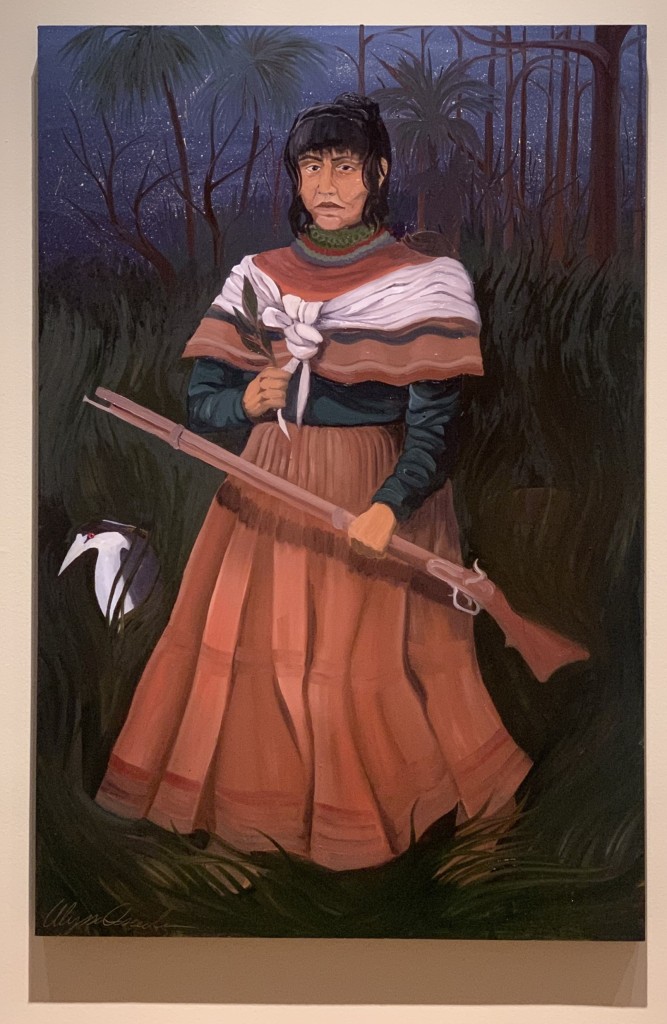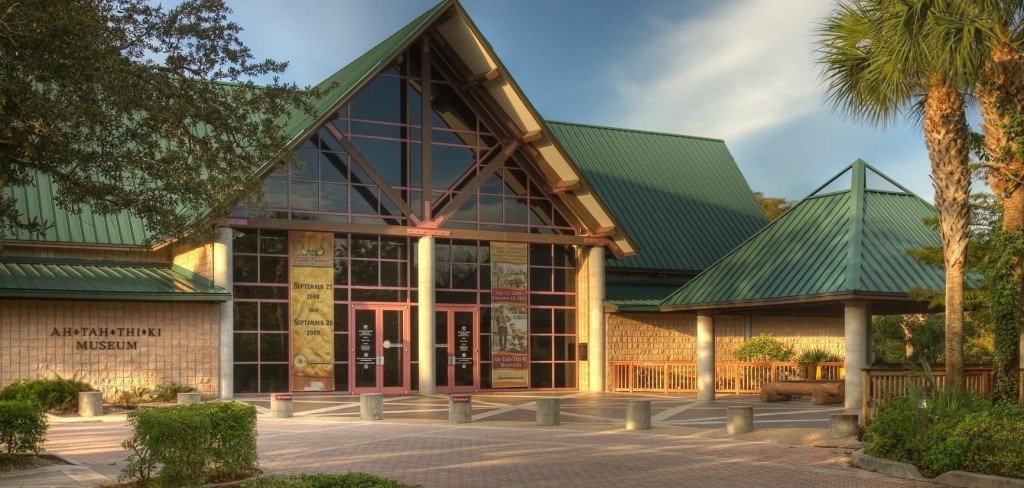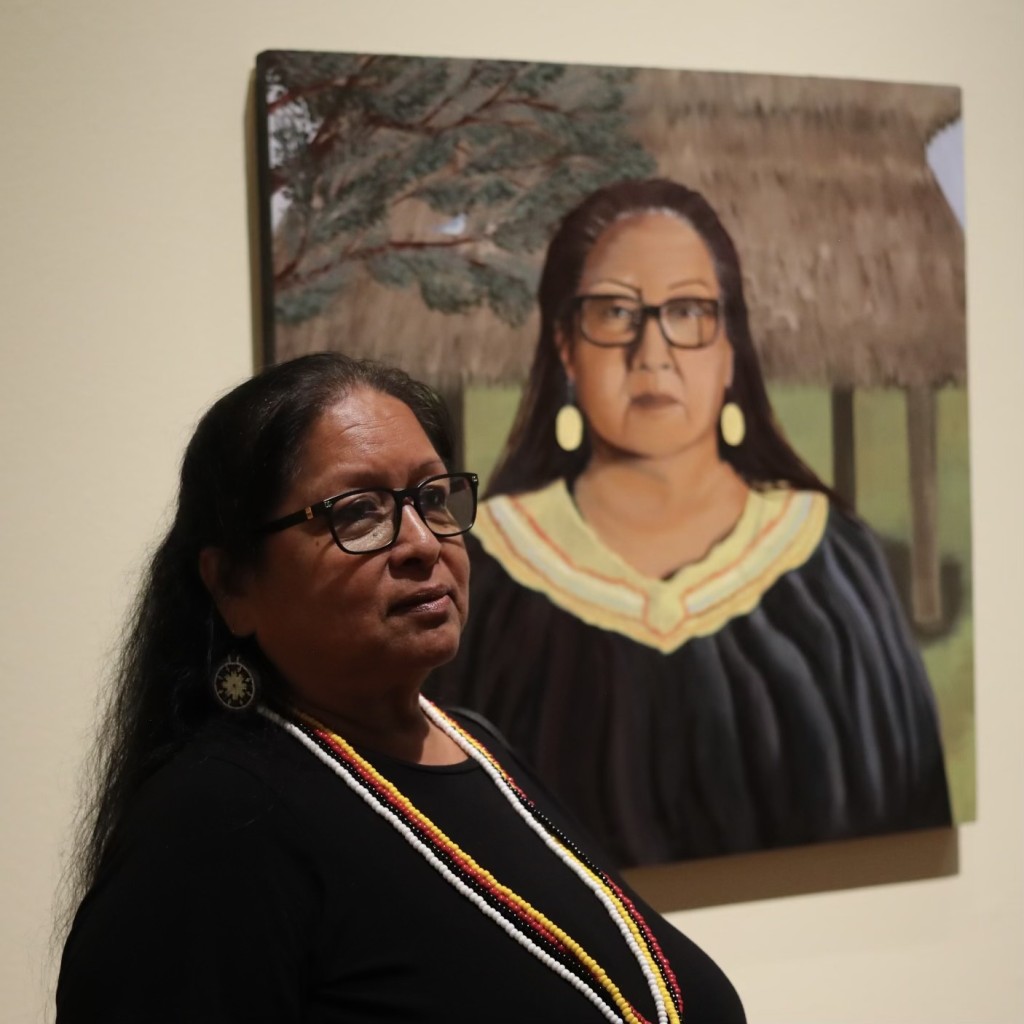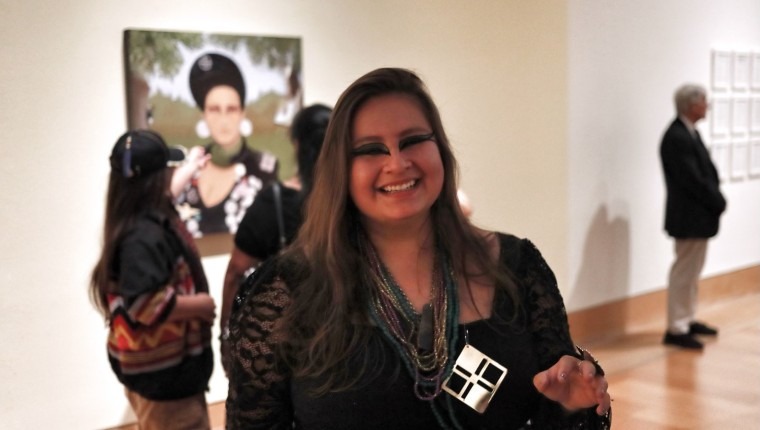Through September 3
Ringling Museum of Art
Sarasota
Details here
Alyssa Osceola is from the Big Cypress Seminole Indian Reservation in South Florida.
She is currently pursuing a BFA in Illustration at Ringling College of Art & Design and is on track to graduate in May of 2023. With work in the Reclaiming Home: Contemporary Seminole Art exhibition at The John and Mable Ringling Museum of Art that opened in March, Osceola has agreed to sit down and talk about her series of portrait paintings, titled Pooshewaache.
Polly Parker, or Emataloye, was the great great great great great grandmother of the artist. A woman so dedicated to her people that she led a large-scale escape from internment, back down to South Florida.
The portrait series continues Polly’s fight to keep native Seminoles at home, on the land that has always belonged to them.
Alyssa Osceola is dressed in all-black leather with steel-toed boots. Her makeup is sleek, eye-catching, and could be mistaken for an elaborate face mask. A preserved warthog skull (ethically sourced) sits on her nightstand next to a wall of beaded earrings and macabre jewelry pieces. Her laugh is strong and squeaky. It sounds like a sneaker on a basketball court. Her mind is razor sharp, which is perfect for a growing artist with a passion for research. She’s eager to discuss her exhibition.
We go into her apartment’s living room where two giant wooden canvases sit against the wall. Atop the burnt umber underpainting she works with oil paints, a fairly new medium for her. Osceola is normally loyal to inks, spray paints, acrylics, pencils, charcoal. But of late, oil has become a valued addition to her tool kit. A stack of palettes sits on the coffee table with several mixtures of primary colors and Galkyd gel.

What are the most important steps of your process?
For these portraits, it involved a lot of archival research. I dug through boxes of family photos as well as digitized museum archival photos, especially from the Ah-Tah-Thi-ki Museum on the Big Cypress Reservation. The team there was very helpful in doing research for certain members of my family since at first, I couldn’t find many photos.
I would then sketch, doodle and capture small studies of features. All before the final sketch I use for the painting. Next, I translate that freehand with an underpainting.
The background elements in the portraits are a fair mixture of photo references and my imagination. Once the underpainting dried, I went in with color and rendered the image. Render. Render. Render.
Who would you say is a big inspiration for your artwork?
Family. Specifically, my great-aunt Janice Billie, my father Charlie Osceola, and late Jimmy Osceola. They have all inspired me in their own ways as artists – each directly encouraging my passion for art throughout life.
I have also been inspired by professors in my time at the Ringling College, namely George Pratt. His help led me to stylistically expanding my skills and techniques – and for that I’m incredibly grateful for his courses.
I am inspired by too many artists throughout history to name, but I have a very full well to draw from for inspiration.
Can you tell us about Polly, who is the centerpiece of your work?
Polly is the major reason why the Seminole tribe is still here in Florida. On May 5, 1858, she organized an escape from being transferred up to the Mississippi River, north of Tampa. She managed to get about six people to escape with her out of a group of probably a dozen, and then made it back to north of Lake Okeechobee within a week.
She had to leave her toddler behind. The escape was so sudden, and they were very sick. We don’t know what happened to the kid, but she had her other child, a newborn, and escaped – because she had to stay here in South Florida.
There were people who killed themselves because they didn’t want to leave. So many. And Egmont Key, where they were held, was an internment camp. That was a very real thing in Florida.
We were fighting tooth and nail just to survive. We were defending ourselves, our land, our spirituality. I make art because I have the privilege of being able to do that.
Do you plan to highlight the events of this escape in your work?
Not the escape specifically. I would have to be a lot more vulnerable than I want to be right now. But, again, Polly is the reason we still have so many Seminoles down in Florida. So, I’ll focus on Polly. Because she’s the matriarch of the line that we know.
I’ve been told there’s an interview from the 1800s with her where she talks about her mothers and grandmothers and I’m still trying to find it, which would be very interesting. Obviously, there are no photos of them, but it would be good to know.
With her painting, it’s going to be a six-foot panel. I’m trying to make it to life-size – and, you know, level playing field with the viewer. Commanding attention.
That’s why all the portraits of my other grandmother, her daughters and granddaughters are going to be all about the same size, but in succession. And then I’m going to do a portrait of myself if time allows for it.
It’s not just a pretty painting of a woman or a mother. It’s women who demand your attention, who in real life were assertive, spoke their minds, and had power within our family unit. Because that’s how it is traditionally, and it’s respected.

Do you see there being a sequel to this project? Or an expansion of the idea?
Definitely. It would be the addition of male family members. They’ve had just as big of an impact on our community, on our family and even the larger indigenous community in America. Tribal sovereignty, tribal religious freedom.
A lot of stuff has happened that even I haven’t really heard about, because it’s not really something that’s taught. Yeah, grandfathers and the stuff they’ve done. I think that would be the next step.
How did you get this opportunity?
This is a project I’ve been working on between senior year of high school and freshman year at Ringling College. It’s all coming together right now.
I was originally trying to get this in the museum at home, the Ah-Tah-Thi-Ki Museum, because they have some art exhibits besides the history and culture stuff.
But then Ola Wlusek contacted me, she said she learned about me at Marco Island. She is the contemporary art curator at The Ringling.

Most of your work surrounds your Seminole heritage. What does this exhibition in an institution like The Ringling symbolize for you?
I was kind of skeptical of Ola. Because I didn’t want it to just be a token thing. Even though she’s showcased indigenous artists before, and engaged with me about my art, I still was unsure.
But she did make a good point – there’s not a lot of contemporary artists in the Ringling.
I’ve never seen myself as a museum gallery person. I much prefer making. Bring attention to things that I think need attention like my family history, like my cultural history. I didn’t see Ringling exhibits in my future.
I also didn’t see a graffiti exhibit in [the Ah-Tah-Thi-Ki] Museum in my plans. But here I am. I’m meeting people who want my artwork. People who respect me.
What are your thoughts on viewing art as a great equalizer for marginalized peoples?
I would say that it is. People began as a group of artists because art used to have function. That’s just something we’ve done for millennia. Everybody can create and communicate with imagery. And I think everybody can create art with a function.
Even if none of my art, for the rest of my life, is in a museum or anything, I want stuff to be left and to be seen. At least by my family. I want to be producing art until I can’t anymore. There’s a quote, “Functionless art is simply tolerated vandalism. We’re the vandals” and it’s plastered on a Type O negative shirt.
Everything is up to the person viewing. I know what meaning something has. I know what I’m trying to convey. If you can’t understand that, even though it’s laid out very clearly in a statement, or just within the piece itself, that’s on you.
Do you believe the empowerment of your family’s matriarchs through portraiture is a softer transition into exploring your past without diving straight into the more traumatic things that have happened to your family?
That’s exactly it. Through my art I’m preserving a lot of women who either go unnoticed or are purposefully ignored. Portraits make sure their likeness is never truly forgotten.
It’s… it’s frustrating. And there is a feeling of loss when I do my research and find out what my family had to endure just for wanting to keep their home. Always. It’s affected me directly.
My dad spoke fluent Miccosukee as a child because my great grandmother raised him. They spoke Miccosukee to him and raised him speaking Miccosukee, so he was fluent until he went to public school, and they were teaching them English on the reservation. Rather than fostering the ability to keep both languages fluent.
So even just me not having any real fluency in the language, that bothers me because it’s an endangered language. There aren’t many fluent speakers left. And sometimes I have a lot of despair about lost language, culture and history.
Do you see a future for yourself outside of South Florida?
My father doesn’t want me to go. He’s very vocal about that, which is fine. I don’t want to leave. I want to stay close. Because I’m also culturally and spiritually tied to the area. I feel an obligation to stay where Polly wanted us.
I can make art wherever, and this is just where I’ve decided to settle. I’m not going anywhere.



